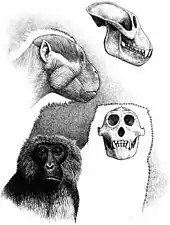Victoriapithecus
Victoriapithecus macinnesi was a primate. It was described from a single fossil specimen, the oldest Old World monkey skull fossil. It was discovered near Lake Victoria in Kenya by Dr. Brenda Benefit. It dates from the middle Miocene and was closely related to the two or three extinct Prohylobates species.
| Victoriapithecus | |
|---|---|
 | |
| Skull | |
| Scientific classification | |
| Kingdom: | Animalia |
| Phylum: | Chordata |
| Class: | Mammalia |
| Order: | Primates |
| Suborder: | Haplorhini |
| Infraorder: | Simiiformes |
| Superfamily: | Cercopithecoidea |
| Family: | †Victoriapithecidae |
| Genus: | †Victoriapithecus von Koenigswald, 1969 |
| Species: | †V. macinnesi |
| Binomial name | |
| †Victoriapithecus macinnesi | |
Description

Victoriapithecus macinnesi had a dental formula of 2:1:2:3 on both the upper and lower jaws. Its lower molars are bilophodont with low cusps. The canines show sexual dimorphism and the mandible is relatively deep compared to other Old World monkeys. On the forelimbs, the distal end of the humerus shows a narrow articulation and a deep ulnar notch. It had an average body mass of around 7 kg (15 lb)[1] and the volume of its brain was 36 cm3.[2][3]
Range and locomotion
Victoriapithecus macinnesi lived in Africa. The postcranial remains indicate it was likely quadrupedal.[1]
References
- Fleagle, John G. (25 September 1998). Primate Anatomy and Evolution (second ed.). Academic Press. pp. 491–495. ISBN 978-0-12-260341-9.
- Old World Monkey Had Tiny, Complex Brain
- Cerebral complexity preceded enlarged brain size and reduced olfactory bulbs in Old World monkeys
External links
- Victoriapithecus macinnesi at members.tripod.com
- Cercopithecidae at Mikko's Phylogeny archive
- Benefit, Brenda R.; McCrossin, Monte L. (June 1991). "Ancestral facial morphology of Old World higher primates" (PDF). Proc. Natl. Acad. Sci. 88 (12): 5267–71. Bibcode:1991PNAS...88.5267B. doi:10.1073/pnas.88.12.5267. PMC 51853. PMID 2052606.
